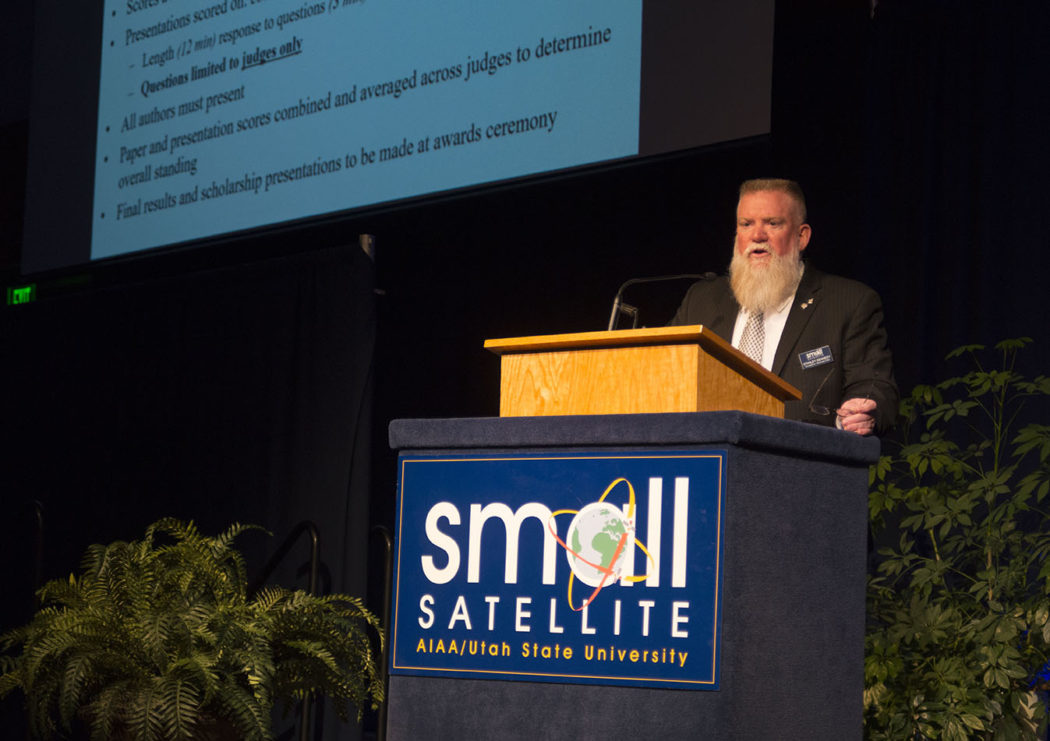The faces behind USU’s largest conference
It’s a sunny Friday morning when two semi-trucks drive up onto the sidewalk between the TSC and the Logan Institute of Religion. As the trucks pull to a stop, volunteers wearing red shirts are instructed to pull out large boxes from the vehicles and put them onto folding platform carts. The boxes have been sitting in storage for almost a year now, waiting for the annual Small Satellite Conference (Small Sat.)
The volunteers are part of a team that works tirelessly behind the scenes to get ready for Small Satellite, a convention that transforms USU and Logan into a hub for engineers. Small Sat is a premier conference for new technologies in satellites. The convention takes place at Utah State University every August.
During this week, the average volunteer will work about 80 hours and, according to logistics coordinator Amy Smuin, “get between four to five hours of sleep every night.”
As the morning progresses, volunteers are hauling large boxes back and forth from the trucks to the TSC, where they will eventually be placed in the TSC’s “Fireside room.” The room will serve as headquarters for the entire conference.
One of the main features for the conference is the different exhibits companies use to talk to the attendees about their products and research. The setup for the exhibits is extensive. The entire second floor of the TSC, as well as most of the George Nelson Fieldhouse, is filled with booths for organizations such as VACCO Industries from California or the Applied Physics Laboratory from John Hopkins University.
Modern Expo, an event design and production service that Small Sat employs, has been inside the TSC all week building the exhibits.
According to Modern Expo production manager Guy Stones, about 2,800 feet of pipe and drape is used in the TSC alone. “We also do custom displays,” Stones said. “For example, the Swedish Space Corporation has asked us to build an 8 by 20 feet LED light box into their booth.”
According to Stones, the entire production began weeks prior to the convention. “Just to get the stuff up here, nine semi-trucks had to be transported to smaller trucks to fit in between the campus buildings; and that was all before anything was even inside the TSC,” Stones said.
Modern Expo provides technical support for the duration of the conference.
In addition to the employees from USU and Modern Expo, 11 students from Cal Poly in California have come to Utah to help out and attend the conference. The day before the convention, they were in the Fine Arts Center stuffing over 2,000 bags with t-shirts, flyers, water bottles, ChapStick, and a SpaceNews magazine printed exclusively for Small Sat.
Conference assistant Samantha Corbridge is inside the Fine Arts Center supervising the students. “This really does take all year to plan,” Corbridge said.
Back at the Fireside room in the TSC, the small conference room has been transformed to resemble a full-scale operation. Boxes, crates, instructions on walls and minute-by-minute schedules for workers, as well as indoor and outdoor item lists, litter the conference table.
Arianna Keller, a Space Dynamics Lab employee and volunteer for Small Sat, is inside opening boxes from the truck.
“I enjoy doing this because it’s nice to get outside and do something different,” Keller said. “I also get to hang out with other people and enjoy spending the week with them.”
After a lunch break, Keller is among several volunteers that will spend the rest of the day hanging up banners and assembling signage for different rooms in multiple buildings. Many of the signs are heavy and need to be transported using the platform carts.
“The only downside to this is that you get really tired,” Keller said. “You work long hours and many of the things we have to move are heavy.”
During the conference week, the weather is not as pleasant. The convention has several days of rain, yet many of the jobs require the volunteers to stand outside.
On the last day of the conference, volunteer Aubrey Work is on the quad, guiding hundreds of people to the tents for a catered lunch. Other volunteers are counting the attendees to ensure that there is enough food for everyone.
“It’s worth it,” Work said. “People will come up and thank me, even if I am just standing here.”
In addition to directing massive crowds during meal times, workers spend the day checking trash, maintaining signs, cleaning up after meals, wiping down chairs and giving everything a fresh look.
The most important thing the workers can do, however, is to be a guide to visitors who may get lost on the huge campus.
“I have a gentleman who has come up to me everyday of the conference and said, ‘How are you going to help me today.’ Then we direct him to wherever he needs to go,” Work said. “It feels good to help people like that, and people are very appreciative.”
As the rain gets worse and people are attempting to leave, Amy Smuin is outside directing traffic.
According to Smuin, Small Sat has become almost a “family tradition.”
“This event started out small, and has grown to over 3,500. Yet people still want to come to Logan,” Smuin said. “They love the historic part of Logan, hiking, seeing the canyon, stuff like that.”
The conference ends with volunteers and USU employees tearing down, within several hours, something that took a week to put up.
The semi-trucks drive back up onto the sidewalks and the boxes are loaded into the truck. Everything will go back to storage and stay there until Small Sat 2020.
taylorcripe@gmail.com
@cripe_taylor

